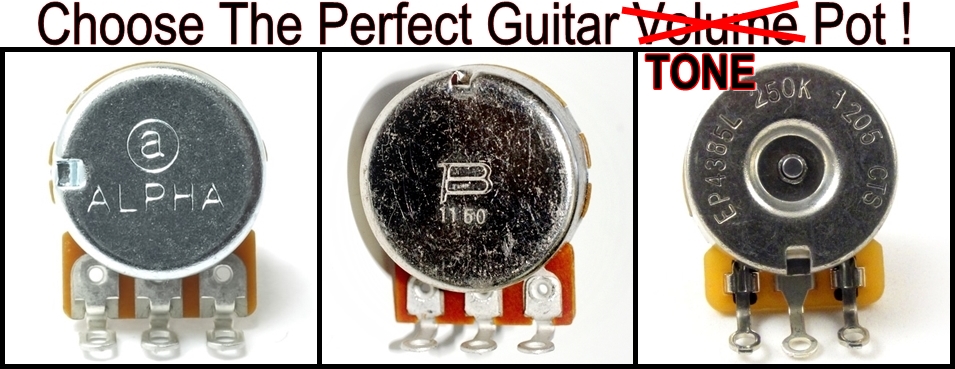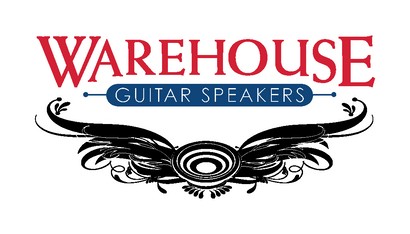Your Cart is Empty
NOW FREE SHIPPING TO 48 CONTIGUOUS UNITED STATES ON ALL ORDERS!!!
Choose The Perfect Guitar TONE Pot
by vaughn skow March 31, 2019 4 min read
Hello once again fellow tone junkies! Welcome to part two in my series on guitar pots, this time around we'll be talking TONE pots. Some would say tone pot selection is not as important as volume pots, and I tend to agree ... but it's close, very close! First, I'll mention that if you also want to know my take on tone CAPACITORS, check out this blog. Okay, ready to roll? Let's jump in. Warning, some of the info will be exactly the same as in my previous blog about VOLUME pots, if you have not yet, please read THAT blog first!

Say you don't care about the how and why of this discussion? OK, here is THIS whole blog in a few bullet points:
- Use quality name-brand close-tolerance pots.
- MOST folks prefer smooth audio-taper (logarithmic) pots for tone controls.
- SOME folks prefer linear-taper tone pots, try both and see what you prefer.
- Use 250K pots for single-coil pickups and 500K pots for humbuckers.
But like I've said before, I know y'all ... you want to know why and how ... right? read on!
First be sure you read the info on what a potentionomer actually is from my blog on Volume Pots.
Now the nuts-n-bolts.
The Value of a TONE pot: this again seems to be what folks most often discuss, and again ... rightfully so, as it is ultimately the factor that most effects tone! A quick refresher on what the "value" of a pot actually TELLS US. Guitar pots are valued as 25K, 250K, 500K, and so on ... but do you know what exactly this means? It is the resistance measured from the center lug to one of the outer lugs, when the wiper is turned as far away from that lug as possible; in other words, it is a measurement of the MAXIMUM amount of resistance the pot can introduce into the circuit when the pot is completely "turned down". In essence, it is a reflection of the type and amount of resistave material used in the pot.Now this is important!The way a simple (and typical) tone control works in a guitar is that a capacitor (which isolates/passes highs) is inserted in the guitar's output and as the tone control is turned down, it simply shunts and eliminates more and more of these high frequencies to ground; by the time the control is fully "down", nearly all the signal passing through the cap is shunted to ground ... thereby eliminating those high frequencies. What some folks fail to realize is that a tone pot all the way "up" is still in the circuit just a little bit. So, how does this effect tone?
The quick answer: even when the tone control is turned up fully, higher value pots will ultimately produce a brighter tone, and lower value pots will produce a less bright tone. Why? Because when a pot is fully turned up, there is still a measurable amount of resistance in the pot; in the case of 500K pots this is usually about 2-5 ohms, and in the case of 250K pots it averages in the 5-12K range, and with a 100K pot it's actually a whopping 100 ohms or more! In other words, even fully "up" the tone control is still shunting a bit of the high frequencies through the tone cap to ground, the higher the value when the pot is turned fully "up", the lower the value is when it's turned fully "down". And so, the 3 ohms or so of resistance in a fully "up" 500K pot results in a brighter tone than the 7 ohms or so of a 250K pot.
The Take-Away: 250K pots are generally used as tone controls on single-coil guitars like Strats and Teles where you need to keep the already bright pickups from getting too bright; 500K pots are generally preferred on the darker humbucker designs to keep them from getting too dark. A side-note: 25K pots are usually used with "active" pickups which contain a built-in pre-amplifier which converts the high impedance of the pickups (8-16K-ohms) to low impedance (100-300 ohms); if you were to replace the pickups in a standard guitar with active pickups and failed to also replace the pots with 25K ... you would wind up with very shrill tone, ugg!
The Next Big Discussion ... the Taper!
I won't repeat all this info from my last blog on Volume pots, just know that most players prefer their tone pots to be logarithmic taper (also called audio taper) ... however, and this is important ... some folks strongly like their tone pots to be linear taper; my suggestion: try both and see what you like! Here is a graphic comparing the linear progression of a pot vs the logarithmic operation of a pot specifically tailored to respond in the same way our ears hear audio.
Here is a great video I ran across with a nice demonstration of how linear and audio taper TONE POTS actually SOUND, check it out.The various BRANDS of pots! EXACTLY the same info as my blog on volume pots, so read it there!
Once again ... If ya just can't get enough of this stuff, check out this episode of my buddy Brian Wampler's Chasing Tone series, we talk about a bunch of crap ... including pots :-)Leave a comment
Comments will be approved before showing up.
